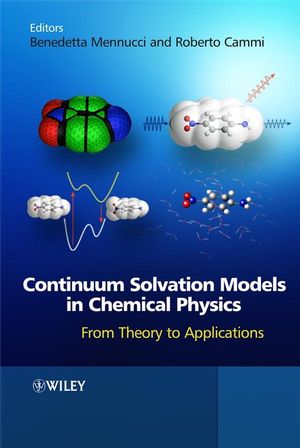Continuum Solvation Models in Chemical Physics: From Theory to ApplicationsISBN: 978-0-470-02938-1
Hardcover
636 pages
January 2008
 |
||||||
1. Modern theories of continuum models.
1.1 The physical model (J. Tomasi).
1.2 Integral equation approaches for continuum models (E. Cances).
1.3 Cavity surfaces and their discretization (C. Pomelli).
1.4 A Lagrangian formulation for continuum models (M. Caricato, G. Scalmani, M. Frisch).
1.5 The quantum mechanical formulation of continuum models (R. Cammi).
1.6 Nonlocal solvation theories (V. Basilevsky & G.N. Chuev).
1.7 Continuum models for excited states (B. Mennucci).
2. Properties and spectroscopies.
2.1 Computational modeling of the solvent effect on NMR molecular parameters by a Polarizable Continuum Model (J. Sadlej & M. Pecul).
2.2 EPR spectra of organic free radicals in solution from an integrated computational approach (V. Barone, P. Cimino & M. Pavone).
2.3 Continuum Solvation Approaches to Vibrational Properties (C. Cappelli).
2.4 Vibrational Circular Dichroism (P. Stephens & F.J. Devlin).
2.5 Solvent effects on natural optical activity (M. Pecul & K. Ruud).
2.6 Raman Optical Activity (W. Hug).
2.7 Macroscopic non linear optical properties from cavity models (R. Cammi & B. Mennucci).
2.8 Birefringences in liquids (A. Rizzo).
2.9 Anisotropic fluids (A. Ferrarini).
2.10 Homogeneous and heterogeneous solvent model for non-linear optical properties (H. Agren & K. Mikkelsen).
2.11 Molecules at surfaces and interfaces (S. Corni & L. Frediani).
3. Chemical Reactivity in the ground and the excited state.
3.1 First and second derivatives of the free energy in solution (M. Cossi & N. Rega).
3.2 Solvent effects in chemical equilibria (I. Soteras, D. Blanco, O. Huertas, A. Bidon-Chanal, & F. J. Luque).
3.3 Transition State Theory and Chemical Reaction Dynamics in Solution (D.J. Truhlar & J. R. Pliego Jr.).
3.4 Solvation Dynamics (B. Ladanyi).
3.5 The role of solvation in electron transfer: theoretical and computational aspects (M.D. Newton).
3.6 Electron-driven proton transfer processes in the solvation of excited states (W. Domcke & A. L. Sobolewski).
3.7 Nonequilibrium solvation and conical intersections (D. Laage, I. Burghardt & J.T. Hynes).
3.8 Photochemistry in condensed phase (M. Persico & G. Granucci).
3.9 Excitation Energy Transfer and the Role of the Refractive Index (V.M. Huxter & G. Scholes).
3.10 Modelling solvent effects in photoinduced energy and electron transfers: the electronic coupling (C. Curutchet).
4. Beyond the Continuum approach.
4.1 Conformational Sampling in solution. (M. Orozco, I. Marchán & I. Soteras).
4.2 The ONIOM Method for Layered Calculations (T. Vreven & K. Morokuma).
4.3 Hybrid methods for molecular properties (K. Mikkelsen).
4.4 Intermolecular interactions in condensed phases: experimental evidences from vibrational spectra and modelling (A. Milani, M. Tommasini, M. Del Zoppo & C. Castiglioni).
4.5 An Effective Hamiltonian method from simulations: ASEP/MD (M.A. Aguilar, M.L. Sánchez, M.E. Martín, I. Fdez. Galván).
4.6 A combination of electronic structure and liquid state theory: RISM-SCF/MCSCF method (H. Sato).



